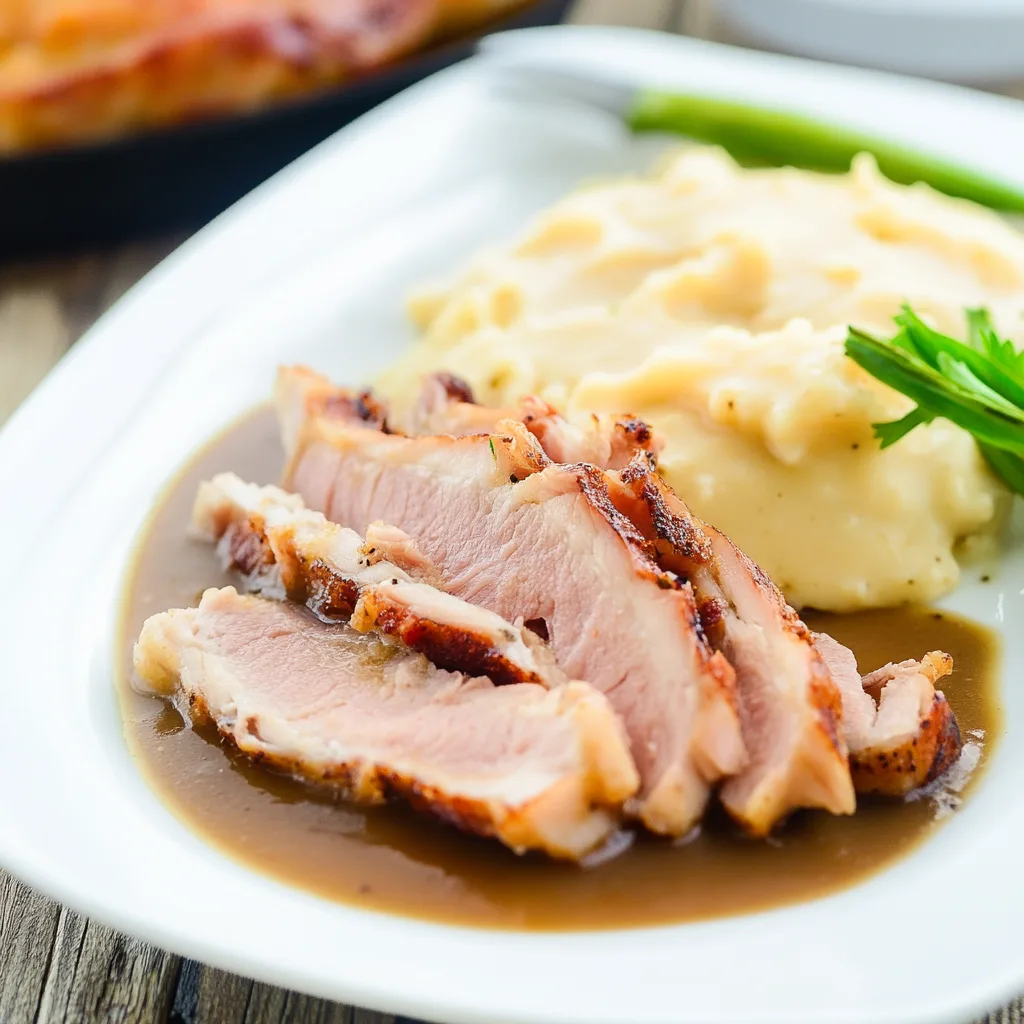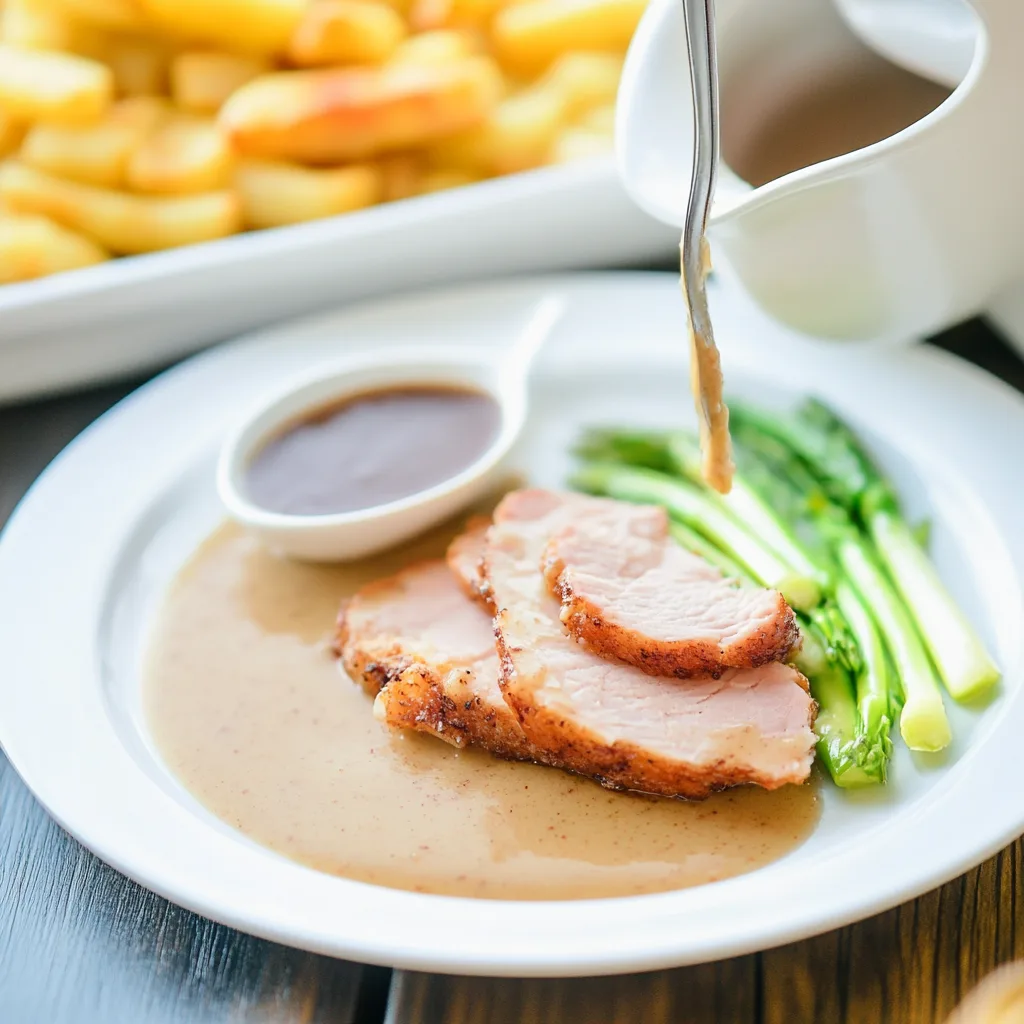Ham Gravy Recipe : The Timeless Charm of Ham Gravy
Ham gravy is a staple in many kitchens, celebrated for its smoky, savory flavor and versatile nature. Whether it’s a holiday feast or a weeknight dinner, ham gravy adds depth and richness to your favorite dishes. Its creamy texture and robust taste make it an excellent accompaniment for classic sides like mashed potatoes, biscuits, and roasted vegetables.
What makes ham gravy so special is its ability to transform simple meals into gourmet experiences. The base of the gravy, often made from ham drippings, captures the essence of roasted ham, providing a flavor that’s both nostalgic and comforting. If you don’t have drippings on hand, a bouillon-based version can deliver the same satisfying results without requiring a roasted ham. For those new to making sauces, mastering how to make a perfect roux is a great starting point to achieve a smooth and lump-free texture.
This recipe isn’t just for holiday gatherings; it’s a year-round delight that fits seamlessly into breakfasts, lunches, and dinners. You can explore variations like red-eye gravy, which incorporates coffee for a bold twist, or create a creamy version perfect for brunch dishes. Regardless of the occasion, ham gravy is a versatile sauce that brings warmth and flavor to the table.
In this guide, we’ll dive deep into the essentials of making ham gravy, explore creative variations, and suggest serving ideas that will elevate your meals. From using traditional ham drippings to modern alternatives like bouillon, you’ll discover how to craft the perfect gravy to complement your dishes.

What is Ham Gravy Recipe?
Ham gravy is a savory sauce traditionally made using drippings from a roasted ham, mixed with flour and butter to form a roux and enhanced with broth or bouillon. The rich, smoky flavor of this gravy makes it a favorite during holidays like Easter or Christmas but equally fitting for year-round meals.
Ingredients of Ham Gravy Recipe
Core Ingredients
- Ham Drippings or Bouillon (2 cups): The base for the smoky flavor.
- Butter (2 tablespoons): For the roux.
- Flour (2 tablespoons): Thickening agent for a smooth texture.
- Salt and Pepper: Adjust to taste.
Optional Ingredients
- Cream or Milk (1 cup): For a creamier variation.
- Coffee (½ cup): Adds a bold twist for red-eye gravy.
- Paprika or Garlic Powder: For enhanced flavor.
Step-by-Step Recipe
1. Prepare the Base
- Collect drippings from a roasted ham or dissolve 3 teaspoons of ham bouillon in 2 cups of warm water.
- Strain to remove solids and ensure a smooth base.
2. Make the Roux
- Melt butter in a skillet over medium heat.
- Gradually whisk in flour, stirring continuously to avoid lumps. Cook for 2–3 minutes until golden.
3. Add Liquid
- Slowly pour the ham broth into the roux while whisking.
- Simmer until thickened, stirring frequently to maintain a smooth consistency.
4. Customize the Flavor
- Add cream or milk for a velvety texture.
- Stir in coffee for a bold red-eye variation.
- Season with salt, pepper, and optional spices to taste.
5. Serve Hot
- Drizzle over ham slices, mashed potatoes, or biscuits for a comforting meal.
Creative Variations
1. Creamy Ham Gravy
- Replace part of the broth with 1 cup of cream or milk for a richer texture.
2. Red-Eye Gravy
- Use brewed coffee as part of the liquid for a bold, smoky twist that pairs well with breakfast items like biscuits and eggs.
3. Gluten-Free Option
- Substitute flour with cornstarch. Dissolve cornstarch in cold water before adding it to the broth to avoid lumps.

Serving Suggestions
- With Ham Slices: The classic pairing for holiday dinners.
- Over Mashed Potatoes: Adds richness and elevates this simple side dish.
- On Biscuits: Perfect for breakfast or brunch.
- As a Sauce: Use over roasted vegetables or as a casserole base.
For more pairing ideas, explore side dishes like smoky baked beans.
FAQs: Your Questions About Ham Gravy Recipe Answered
General Questions About Ham Gravy
What If I Don’t Have Ham Drippings?
If you don’t have drippings from a roasted ham, don’t worry! You can use ham bouillon as a flavorful alternative. Dissolve 3 teaspoons of bouillon in 2 cups of warm water to create a base that mimics the savory, smoky taste of ham drippings. Adjust the amount of bouillon to suit your taste, as it can be quite salty.
Can I Make Ham Gravy Ahead of Time?
Yes, ham gravy can be prepared up to a day in advance. Once it’s made, let it cool and transfer it to an airtight container. Store it in the refrigerator and reheat gently on the stovetop before serving. Add a splash of broth, milk, or water to restore its original consistency if it thickens too much during refrigeration.
What’s the Best Way to Serve Ham Gravy?
Ham gravy is incredibly versatile and pairs well with a wide range of dishes, including:
- Sliced ham for a classic holiday pairing.
- Mashed potatoes or sweet potatoes for a creamy, savory topping.
- Biscuits or dinner rolls for a comforting breakfast or brunch.
- Roasted vegetables like carrots, green beans, or Brussels sprouts.
Dietary Modifications and Customizations
How Can I Make Gluten-Free Ham Gravy?
To make gluten-free ham gravy, substitute flour with cornstarch or arrowroot powder. Dissolve the cornstarch in cold water before adding it to the hot broth to avoid lumps. Use about 1 tablespoon of cornstarch mixed with 2 tablespoons of cold water for every cup of liquid in your gravy.
Can I Make a Dairy-Free Version?
Yes! Use oil or a plant-based butter alternative instead of regular butter to create the roux. If the recipe calls for cream or milk, replace it with unsweetened almond milk, oat milk, or coconut cream for a dairy-free alternative.
How Do I Balance Salty Gravy?
Ham drippings and bouillon can sometimes result in overly salty gravy. To fix this:
- Add a splash of cream or milk to dilute the saltiness.
- Incorporate unsalted broth or water to balance the flavor.
- Include a starchier side, like mashed potatoes, to help absorb the salt.
Troubleshooting Common Issues
Why is My Gravy Too Thin?
Thin gravy can occur if the roux isn’t thick enough or the liquid-to-roux ratio is off. To fix this:
- Simmer the gravy for longer to reduce and thicken it naturally.
- Add a cornstarch slurry (1 tablespoon cornstarch mixed with 2 tablespoons water) to the simmering gravy and whisk until thickened.
What Causes Lumpy Gravy, and How Can I Fix It?
Lumpy gravy usually happens when the roux and liquid aren’t whisked together properly. Prevent lumps by:
- Adding the liquid to the roux slowly, whisking continuously.
- Straining the gravy through a fine-mesh sieve if lumps form despite your efforts.
Why Does My Gravy Taste Bland?
If your ham gravy lacks flavor, try the following:
- Add more seasonings like black pepper, garlic powder, or smoked paprika.
- Use a stronger broth or bouillon for a richer flavor.
- Stir in a tablespoon of soy sauce or Worcestershire sauce to deepen the umami taste.
Storage and Reheating
How Long Can I Store Ham Gravy?
Store ham gravy in an airtight container in the refrigerator for up to 3 days. If you plan to keep it longer, freezing is a better option.
Can I Freeze Ham Gravy?
Absolutely! Freeze ham gravy in a freezer-safe container for up to 1 month. To reheat, thaw it in the refrigerator overnight, then warm it gently on the stovetop, adding a bit of broth or water if needed to restore the texture.
How Do I Reheat Gravy Without It Splitting?
Reheat gravy on the stovetop over low to medium heat, stirring frequently. Avoid using high heat, as it can cause the fats to separate. If the gravy thickens too much, add a splash of water or broth to loosen it.
These FAQs cover everything from ingredient substitutions to troubleshooting, ensuring that your ham gravy turns out perfect every time. Whether you’re a beginner or an experienced cook, these tips will help you create a flavorful and versatile sauce for any occasion.
Internal Linking Opportunities
- Pair this gravy with creamy baked beans recipes for a complete meal.
- For a slow-cooked dinner, try Slow Cooker Chicken and Gnocchi.
- Use leftover gravy creatively in a Leftover Sausage Gravy Casserole.
Conclusion : Ham Gravy Recipe
Ham gravy is more than just a sauce—it’s a culinary companion that transforms everyday dishes into rich, flavorful meals. With its smoky, savory profile and versatile nature, ham gravy can enhance holiday feasts, casual weeknight dinners, or hearty breakfasts. Whether you drizzle it over tender ham slices, creamy mashed potatoes, or fluffy biscuits, this gravy brings warmth and satisfaction to the table.
The beauty of this recipe lies in its adaptability. Whether you have roasted ham drippings or opt for a bouillon-based alternative, the process is straightforward, and the results are always rewarding. You can customize your gravy to suit your preferences, from adding cream for a velvety texture to incorporating coffee for a bold red-eye variation. Dietary modifications like gluten-free or dairy-free versions make this recipe accessible to all, ensuring no one misses out on its deliciousness.
Ham gravy also encourages creativity. Use it as a base for casseroles, mix it into pasta for a unique twist, or serve it alongside roasted vegetables for a complete meal. Its ability to pair seamlessly with both classic and modern dishes makes it a staple in any home cook’s repertoire.
By following this guide, you’ve learned not only how to master the basics of making ham gravy but also how to troubleshoot common issues and explore exciting variations. Next time you’re cooking ham or planning a meal that needs a touch of savory indulgence, let ham gravy be your go-to addition. With its timeless appeal and comforting flavors, this sauce is sure to become a cherished favorite in your kitchen.
Take the time to try it today and see how ham gravy can elevate your meals from simple to spectacular. Bon appétit!.


